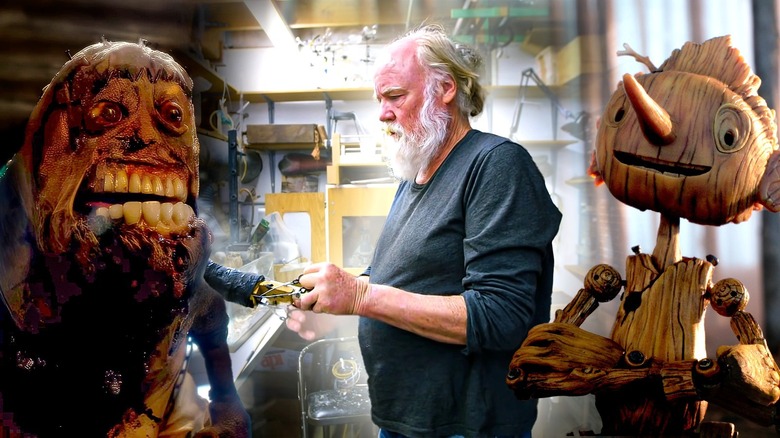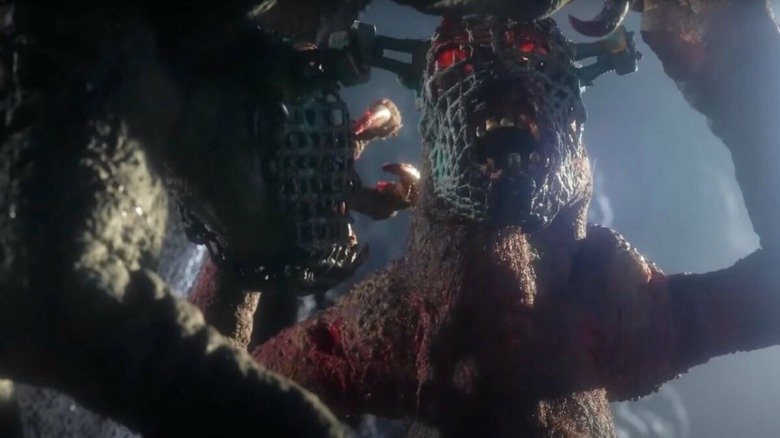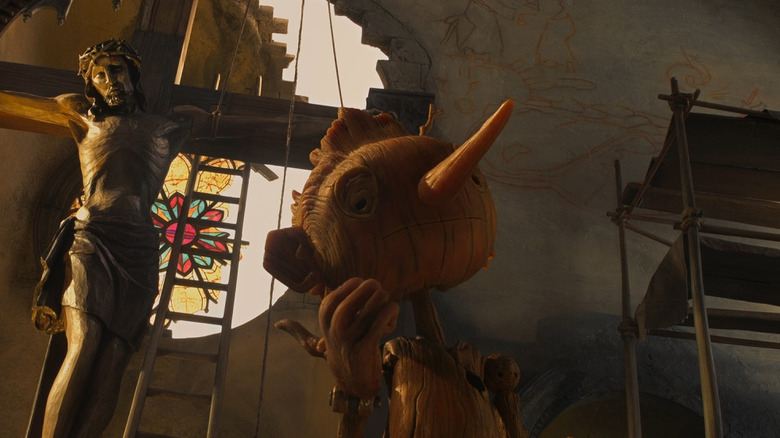Phil Tippett's Mad God And Guillermo Del Toro's Pinocchio Prove Stop-Motion Is The Future Of Creative Filmmaking
Stop-motion animation can be traced back to the earliest days of cinema. The first known film to use this art form, "Humpty Dumpty's Circus," was produced in 1898, paving the way for more stop-motion films to emerge in the silent era and beyond. However, as filmmaking technologies have improved, animation has evolved (or regressed, depending on how you look at it). These days, stop-motion animation mostly takes a backseat to the CG variety, which is more modern and less time-consuming.
But there comes a time when everything that was once old is new again. Like rock 'n' roll music, stop-motion animation will never die, but some prominent filmmakers have fought to keep the medium alive in recent times. One could even argue that stop-motion animation is experiencing a resurgence thanks to the success of Phil Tippett's "Mad God," Guillermo del Toro's "Pinocchio," and Henry Selick's "Wendell and Wild," and LAIKA Studios. Long may it continue.
There's room for every form of animation to flourish on the screen, but stop-motion deserves to keep a seat at the big boy table moving forward. The success of "Pinocchio" proves that there's an audience for these types of movies, and that's because stop-motion animation boasts qualities that other forms don't. With that in mind, let's look at why one of cinema's oldest art forms deserves to be the future of animation.
Stop-motion animation is a labor of love
There's no denying that CG animation has lent itself to many brilliant movies and shows throughout the years. The Pixar library is proof of that, and movies like "Soul," "Inside Out," and the "Toy Story" franchise are masterworks of heartfelt storytelling and artistic expression. The thing about CG animation, though, is that it's always clean and perfect. Stop-motion, meanwhile, is rough around the edges, and that's a good thing.
Phil Tippett's "Mad God" chronicles one man's nightmarish journey through the underworld as he contends with grotesque monsters, demons, and torture. The movie is frightening, bleak, and disturbing, but the artistry is undeniable and beautiful. Tippett and his team worked on the film for 30 years, and that passion is tangible in every frame. There's truly nothing else like "Mad God," and the stop-motion is the key ingredient of its uniqueness.
Stop-motion is rough around the edges because it's actually painful to make. For a start, filmmakers need to build their own sets, puppets, objects, etc, and that's a task in and of itself. That's the easy part, though, as turning the movies into living, breathing spectacles involves lots of photographing and manipulating objects. It sometimes takes hours to create seconds of one scene, so you can understand why stop-motion projects aren't dominating the market. "It's the worst way to make a movie," LAIKA's Travis Knight told Forbes. "It makes no sense. You're cutting your hands and contorting your body. But it's an incredible art form that is so rare and so beautiful."
Is making a stop-motion animation movie a crazy idea? Perhaps. Is it worth it? Absolutely. Stop-motion animation represents the purest expression of the artistic process, and that type of authenticity leads to more interesting art being brought to life.
Stop-motion lends itself to mature animation
The recent stop-motion resurgence has produced some pretty complex and thought-provoking movies. "Mad God" is a surrealist trip that highlights the inherent creepiness of stop-motion puppets in a horror setting, and it should only be viewed by adults. That being said, some recent kid-friendly films have also used the style to convey mature ideas and themes.
Guillermo del Toro's "Pinocchio" — a movie about a living puppet that must contend with an authoritarian society that shuns him — uses stop-motion animation to emphasize the film's central theme of fascism and how these regimes control people. As del Toro told the New York Times, "It was clear to me that the film needed to be done in stop-motion to serve the story about a puppet that lives in a world populated by other puppets who think they are not puppets."
"Wendell and Wild," meanwhile, uses actual demons as a metaphor for overcoming personal demons. Henry Selick is no stranger to stop-motion animation given that he made "A Nightmare Before Christmas," and "Coraline." While speaking to Mashable, he said that he likes this style as he believes it has more charm and showcases more artistry. The evident human touch also adds a more soulful quality to "Wendell and Wild" that only enriches the existential ideas it explores. Stop-motion is more intimate than other forms of animation, and therefore perfect for telling stories with humanity and depth.
Thanks to Guillermo del Toro, the future of stop-motion looks promising
It remains to be seen what the future holds for stop-motion animation, but it looks healthy right now. "Pinocchio" seems to have awoken something in Guillermo del Toro, as he has set his sights on making a stop-motion adaptation of Kazuo Ishiguro's "The Buried Giant" for Netflix. Furthermore, he's also toyed with the idea of turning his long-gestating "At the Mountains of Madness" project into a stop-motion horror movie, but we'll believe that project is happening when we actually see it.
Of course, animation houses such as Aardman and Laika are still going strong, and fans can always rely on them to deliver great stop-motion projects. Aardman even produced a short for "Star Wars Visions" Season 2, which is a pretty big deal as that franchise is huge. Of course, Lucasfilm and Disney should also consider letting Aardman make a full stop-motion animation just to spice up the galaxy far, far away.
At this moment in time, stop-motion seems to be moving onwards and upwards, albeit slowly. Slowness is the nature of stop-motion, though, and snail-paced productions are better than none at all. It's a good time to be a fan, but more artistic visionaries should consider embracing this style for their future projects.



